“Israel’s Black Panthers: The Radicals Who Punctured a Nation’s Founding Myth,” by Asaf Elia-Shalev, University of California Press, 2024.
In January 1971, a short news report appeared on the back page of the left-leaning Israeli newspaper, Al Hamishmar. The editors evidently didn’t think much of the story, but its publication caused an immediate sensation. The headline, a quote from one of the article’s subjects, foretold the emergence of a revolutionary new movement from Jerusalem’s Musrara neighborhood that would set off a political earthquake on Israel’s streets — one whose aftershocks can still be felt today. “We want to organize against the Ashkenazi government and establishment,” it read. “We will become the Black Panthers of the State of Israel.”
The adopted name was deliberately provocative. The Israeli media had regularly vilified the original Black Panther Party in the United States — a militant Black power organization founded some five years earlier in Oakland, California — as antisemitic for denouncing Israel as an imperialist state and expressing solidarity with the Palestinian liberation movement. But the Israeli Panthers’ identification with their American counterparts went beyond merely borrowing their name: in the Black struggle against racism, poverty, and police brutality, the Jerusalem youths saw their own experience reflected back at them.
In today’s terms, the Israeli Panthers were not actually Black; they were the sons and daughters of the Jewish exodus from the Arab world, known nowadays as Mizrahi Jews (plural: Mizrahim), but more commonly referred to at the time as Sephardim. These Jews arrived in their hundreds of thousands to a fledgling Israeli state in the early 1950s. But they soon found themselves being racialized as Black by a hegemonic Ashkenazi class, tracing its heritage to Europe, whose vision of a Jewish state had not much accounted for Mizrahim before the Holocaust eliminated two-thirds of European Jewry.
Israel’s Ashkenazi founders — including David Ben-Gurion, the first prime minister — greeted the Mizrahi arrivals with an abundance of racist disdain. The authorities hosed them down with pesticide; settled them in remote desert camps or crammed them into the homes of exiled Palestinian refugees (such as those in Musrara); proletarianized them and funneled them into menial labor; suppressed their culture; separated thousands of them from their children; and forced tens of thousands to undergo unsafe radiation treatment that led to serious health complications. All the while, a rebellion was brewing.
When a group of impoverished Mizrahi youths announced the establishment of their movement and declared a revolt against the system, local and international reporters flocked to interview them. Within weeks, the Panthers counted hundreds, if not thousands, among their ranks, and led a series of escalating protests and direct actions designed to make it impossible for the Israeli authorities to ignore them. They demanded that the state channel its resources toward addressing the stark social problems that plagued Mizrahim, pulling back the curtain on Israel’s supposedly socialist ethos.
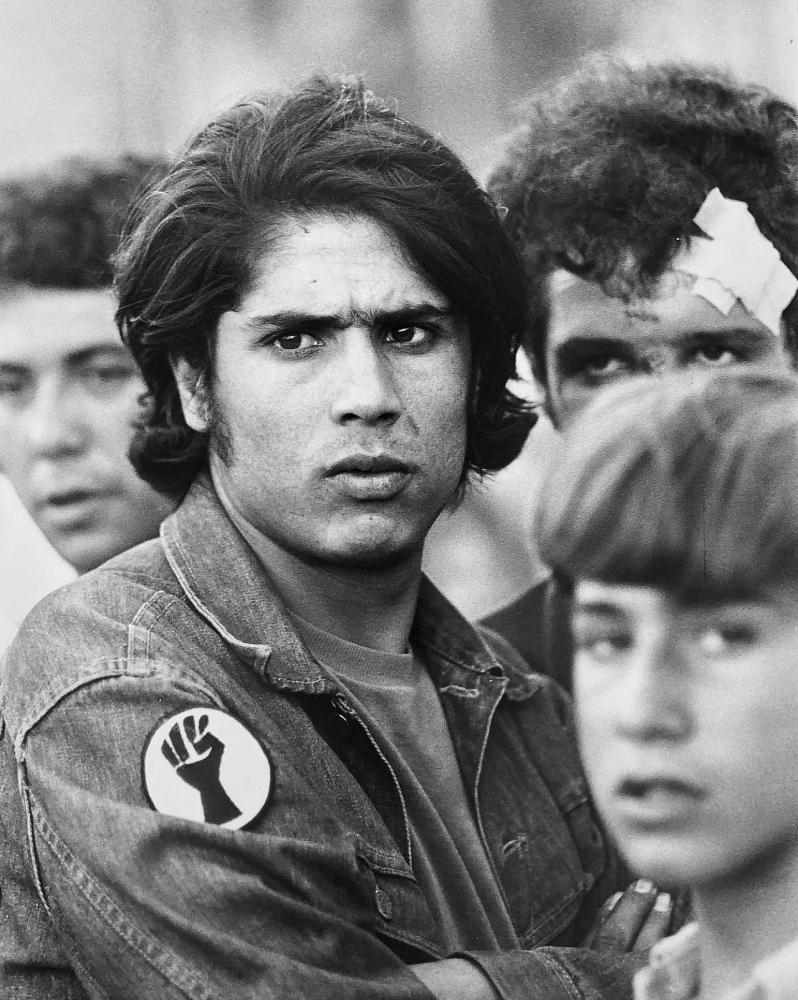
Saadia Marciano photographed on Jerusalem’s Jaffa Street, 1971. (Meir Wigoder)
The authorities, however, denied that any such problems existed, and instead sought to suppress the Panthers’ struggle. Police violently cracked down on the protests, and infiltrated the organization with a mole who would feed them information for years — and who was almost accidentally elected the group’s leader, before convincing them to choose somebody else.
Golda Meir, the prime minister at the time, saw the Panthers primarily as a public relations issue, fearing that their activities could give Israel and Zionism a bad name abroad and discourage Jews in the diaspora from immigrating. “I want to get it out of your heads that you have brought a revolution to the country,” she told a group of Panther leaders with whom she agreed to meet in April 1971, after they had initiated a hunger strike in front of the Western Wall. Echoing her infamous denial of the existence of a Palestinian people, she insisted: “There is no issue of Ashkenazim and Sephardim here.”
A month later, the Panthers mobilized thousands to a demonstration in downtown Jerusalem, which ended with protesters hurling glass bottles, bricks, rocks, and even Molotov cocktails at police. Immortalized as “The Night of the Panthers,” it was the largest civil disturbance that the Israeli authorities would face until a mass uprising of Palestinian citizens of the state five years later, which has been commemorated every year since as Land Day.
A contested legacy
Despite their seismic entrance into Israeli history, half a century later, the Panthers and their rebellion have been largely — and perhaps wilfully — forgotten. Their memory is primarily kept alive only by a few surviving Panthers, a handful of dedicated archivists and historians, the Mizrahi left in Israel and abroad, and parts of the broader Israeli radical left. But the Panthers’ relevance, argues Israeli-American journalist Asaf Elia-Shalev in a meticulous new book, is enduring.
“I was captivated,” Elia-Shalev writes in the preface, “by how a group of kids with criminal records and a provocative name helped redirect the course of the national conversation and forced Israel to face issues it had been denying. What I was slowly learning about the Panthers seemed deeply consequential, and in their forgotten story, I saw the roots of the country that Israel has become.”
“Israel’s Black Panthers: The Radicals Who Punctured a Nation’s Founding Myth” is the first English book to deal exclusively and comprehensively with this turbulent chapter of history. It was born out of an encounter that the author had about a decade ago with one of the Panthers’ central figures, Reuven Abergel.
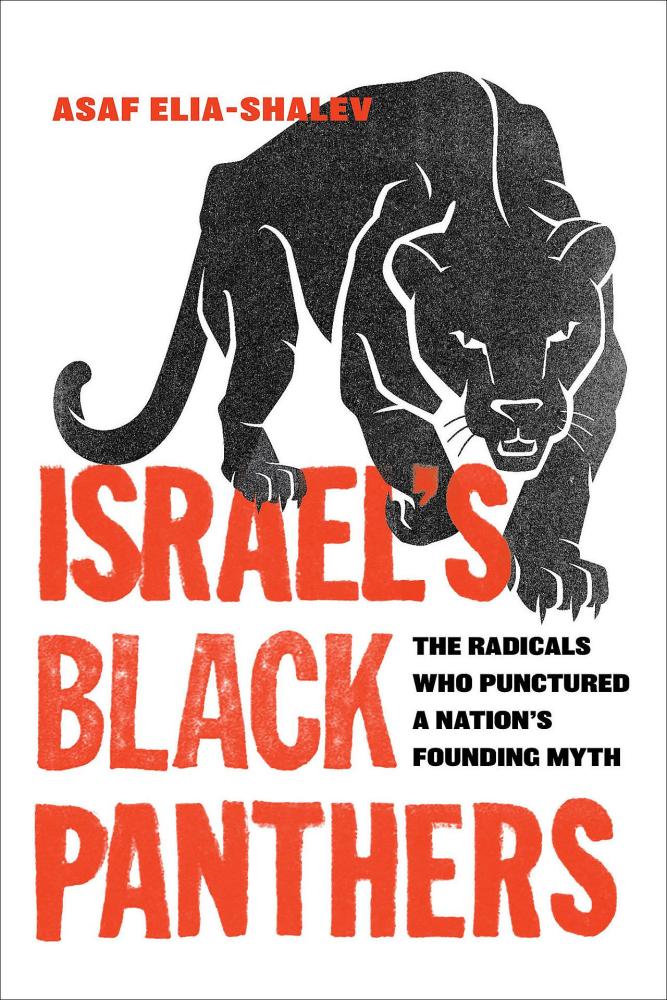
“Israel’s Black Panthers: The Radicals Who Punctured a Nation’s Founding Myth,” by Asaf Elia-Shalev, University of California Press, 2024.
“I went on a tour of Musrara that Reuven led, and my mind was just blown by this guy,” Elia-Shalev recalled in an interview with +972. “He was around 70 years old at the time, and he had this fire and sense of urgency, and spoke so compellingly about his life. I had just read the autobiography of Malcolm X, and Reuven sounded like him in lots of ways; he was saying such powerful things. So I thought, how come no one has heard this story?”
Over the next several years, Elia-Shalev would record some 50 hours of interviews with Abergel, which eventually became the foundation of the book. Abergel does not speak English, and he told Elia-Shalev — who is himself the grandchild of Mizrahim who immigrated to Israel from Iraq — that telling his story to an American journalist in Hebrew felt like “smuggling a letter out of prison.”
Though the author would go on to interview dozens more Panthers, Abergel’s recollections were crucial because he was the only one among the group’s leadership cadre who had not yet passed away or lost his full faculties. “Saadia Marciano died long before I got started,” Elia-Shalev said. “Charlie Biton, when I got to him, was very sick and unable to sit down for interviews with me for very long, and the same with Kochavi Shemesh” — both of whom have since also died.
Elia-Shalev concedes that, given the ideological and personal fissures that later plagued the Panthers, the emphasis on Reuven’s point of view risks privileging a certain perspective on events. But he mitigated this by scouring archives, old news articles, and a previously classified Israeli police intelligence file to find everything he could on the Panthers’ activities, how they were received, and the authorities’ attempts to repress them.
“There are battles over the legacy of the Panthers,” Elia-Shalev explained. “I did my best to be faithful to the facts, but I’m also limited by the materials available and the people that are still around. Reuven is someone who has spent the last decades of his life, long after the Panthers, involved in virtually every social justice struggle in Israel. And that has definitely given him a lot of credibility to speak on the Panthers others have died or didn’t remain involved in activism.”
Indeed, in recent years, Abergel has been a regular fixture at protests against Israel’s occupation of the Palestinian territories, the cost of living in the country, and government plans to deport asylum seekers. But he reflects back on what became of the Panthers’ revolt somewhat wistfully, telling Elia-Shalev: “In every revolution, the dreamers sow the seeds, the courageous carry it forward, and the bastards reap the fruits of the struggle.”
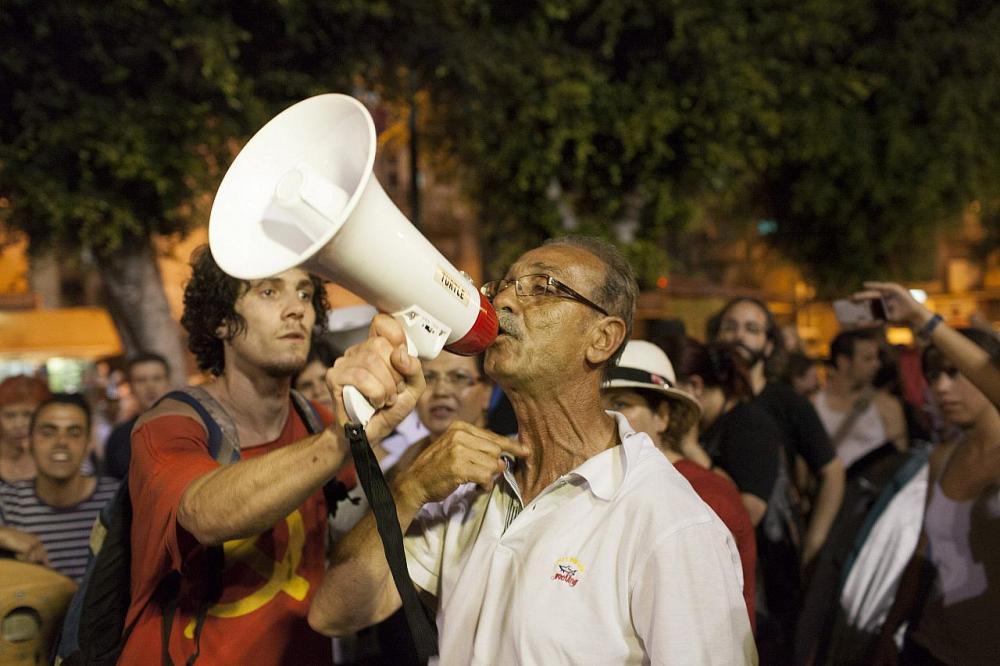
Israeli Black Panther Reuven Abergel addressed a crowd at the Levinksy Park protest camp in south Tel Aviv, July 26, 2011. (Oren Ziv/Activestills.org)
Rebelling to belong
The Panthers were hardly the first Mizrahim to challenge the racism and discrimination they faced in Israel. Initially, resistance took the form of new arrivals urging friends and relatives outside Israel to defy the Zionist emissaries encouraging them to immigrate; some of their letters never reached the intended recipients because the Israeli government’s Censorship Bureau confiscated them, deeming them a national security risk.
By mid-1949, Mizrahim had already begun demonstrating at government buildings across the country to demand better housing, jobs, and food provisions. Protests continued to spring up throughout the 1950s in ma’abarot (tent camps for new immigrants) and the development towns that replaced them, which the police promptly suppressed.
In 1959, a police officer shot a Mizrahi resident of Haifa’s Wadi Salib neighborhood — where the state had densely settled Mizrahim in Palestinian homes confiscated after the Nakba — leading hundreds to flood the streets in fury. Under the leadership of the Union of North African Immigrants, the protesters called for the elimination of the ma’abarot and urban slums, and demanded quality education for all citizens.
The authorities eventually quelled the rebellion, which had spontaneously spread to other Mizrahi localities as well. A government commission of inquiry into the events insisted that Mizrahim in Israel do not face discrimination on the basis of their ethnicity.
More than a decade later, however, even with their share among Israel’s Jewish population being roughly equal, the socioeconomic gaps between Mizrahim and Ashkenazim remained stark. This was perhaps most apparent in the education system, where a majority of Mizrahi adolescents were not in school, while Ashkenazim comprised about 99 percent of university students.
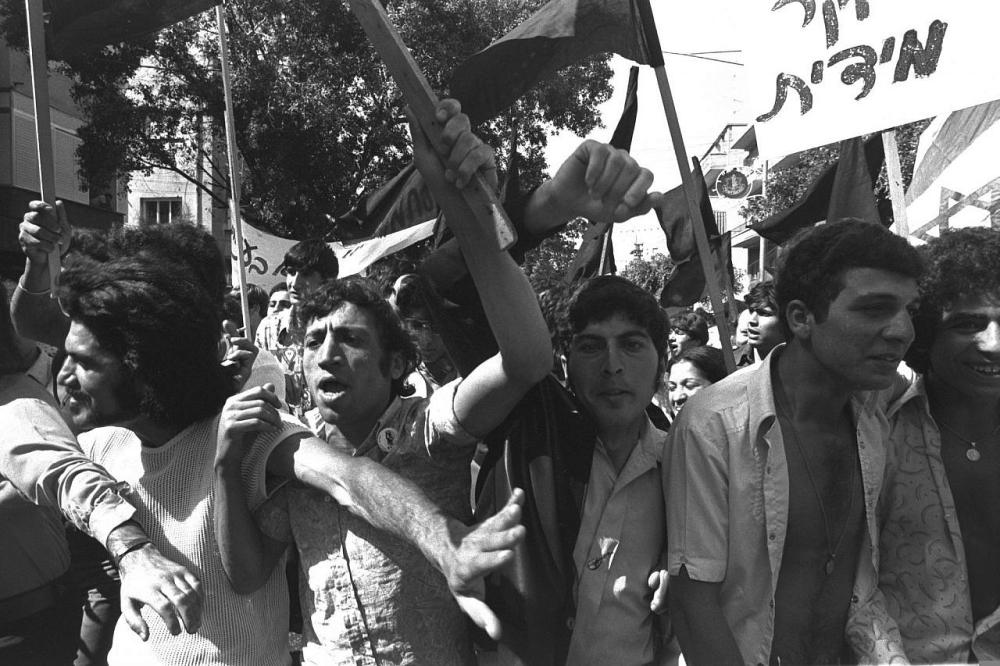
Israeli Black Panthers, including Charlie Biton, protesting on Dizengoff Street in Tel Aviv, May 1, 1973. (Moshe Milner/GPO)
What distinguished the Panthers from those who preceded them, though, was the extent to which the Israeli establishment viewed the organization as a threat. As if to emphasize that danger, the police and media initially sought to portray the Panthers as being in league with the anti-Zionists of Matzpen — a Marxist group largely made up of middle-class Ashkenazim — which the Israeli media had spent much of the past decade demonizing.
“There was this racist urge to say that these young Mizrahi men couldn’t possibly be organizing of their own accord, and they must be puppets on a string,” Elia-Shalev told +972. While Matzpen offered some support to the Panthers — such as by printing flyers and T-shirts for their protests, and amplifying their struggle in Matzpen’s journal — the Panthers were wary of allowing too much room for external influence over their activities. At one meeting where Ashkenazi activists were felt to have overstepped the mark, Elia-Shalev explained, “Reuven and his brothers physically kicked them out.”
The Panthers’ relationship to Zionism, meanwhile, was much less clear-cut. Throughout the book, the reader can discern a constant tension between the Panthers’ repudiation of the Israeli regime and their apparent desire to be welcomed into it as equal partners. From action to action, and perhaps from activist to activist, the group seems to have oscillated between these two tendencies.
On the one hand, the Panthers’ backing for a Palestinian state put them firmly at odds with all but the tiniest minority of Israeli Jews at the time. On multiple occasions throughout the 1970s, representatives of the Panthers contravened Israeli law by meeting with, or trying to meet with, Yasser Arafat and other figures in the Palestine Liberation Organization (PLO), which at the time was committed to armed struggle in pursuit of liberation.
Moreover, at demonstrations, Panthers frequently chanted “Less for the Phantoms” — the name of the fighter jets that the United States sold to Israel — “and more for the Panthers.” And to protest what they saw as the state’s hypocritical support for the liberation of Soviet Jewry while Mizrahim languished in poverty in Israel, they tried to disrupt the 1972 World Zionist Congress.
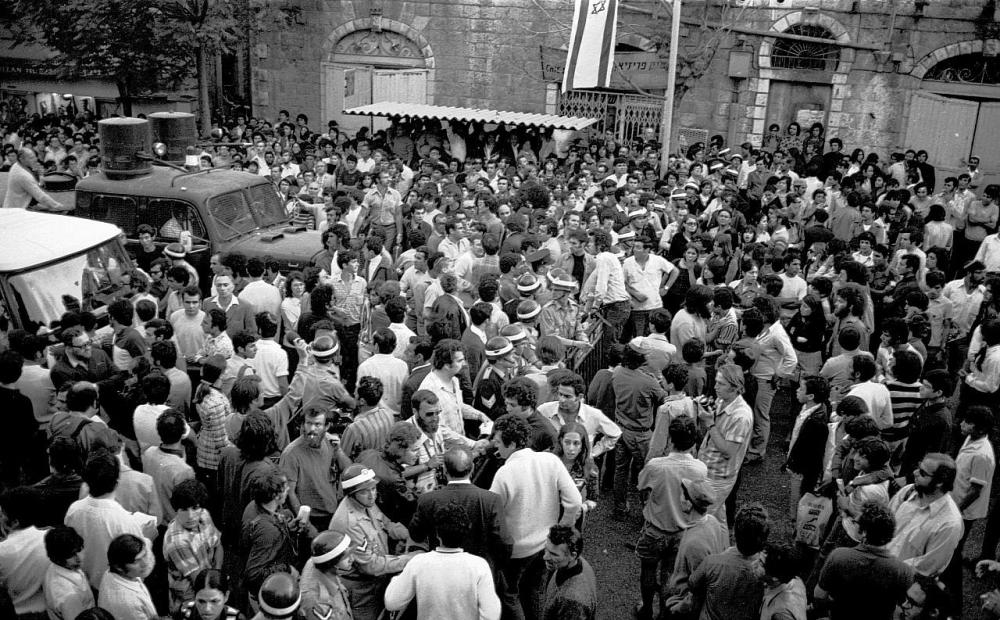
A Black Panthers protest in Jerusalem, 1971. (Yosef Hochman, courtesy of the Yad Yaari Research and Documentation Center)
But the Panthers’ rebuke of core Zionist tenets only went so far. The flyers for their first official demonstration ended with the sentence: “We will demonstrate for our right to be like all the other citizens in this country.” Another rally ended with the singing of Hatikvah, Israel’s national anthem. And in their meeting with Golda Meir, Abergel — who only later became avowedly anti-Zionist — assured the prime minister that the Panthers are “devoted to our country, and patriotic, and we love it.”
For Elia-Shalev, this ambivalence is one of the main differences between the Israeli Panthers and their U.S. counterparts. “The American Black Panthers were real ideologues, real revolutionaries, who wanted to join with the oppressed people of the world and create a new order,” he said. “The Panthers weren’t quite there. In my view, they talked a big game, used phrases like ‘by any means necessary,’ and threatened to overthrow the state, but I think they ultimately wanted to belong.
“They saw the Palestinian struggle as a legitimate one, and they defined Mizrahim as a potential bridge to the Arab world,” he continued. “But fundamentally, they thought it was wrong that the Jewish state would marginalize more than half of its Jewish population. They were hurt that they were denied an opportunity to belong to society and the state, and were willing to at least threaten to overthrow it in order to get a seat at the table. Whatever Zionism is or was, it wasn’t serving Mizrahim, and so the Panthers came out against the people who represented it.”
An avenue into power
In March 1972, the Panthers carried out one of the stunts for which they are most widely remembered — “Operation Milk” — stealing milk bottles from the doorsteps of one of Jerusalem’s wealthiest neighborhoods and delivering it to the poor, for whom fresh milk was vastly unaffordable. Support for the Panthers was growing; one survey in mid-1971 put it at around 40 percent among Jewish Israelis. And it was having a tangible impact: the state budget for 1972 — which has been retrospectively labeled “The Budget of the Panthers” — saw substantial funding diverted from defense spending to housing, welfare, and education.
The organization was also gaining prominence abroad. In September 1971, the New York Times ran a cover story on them. Left-wing radicals from Europe scrambled to meet them, and Panther leaders took up invitations to attend political summits around the world.
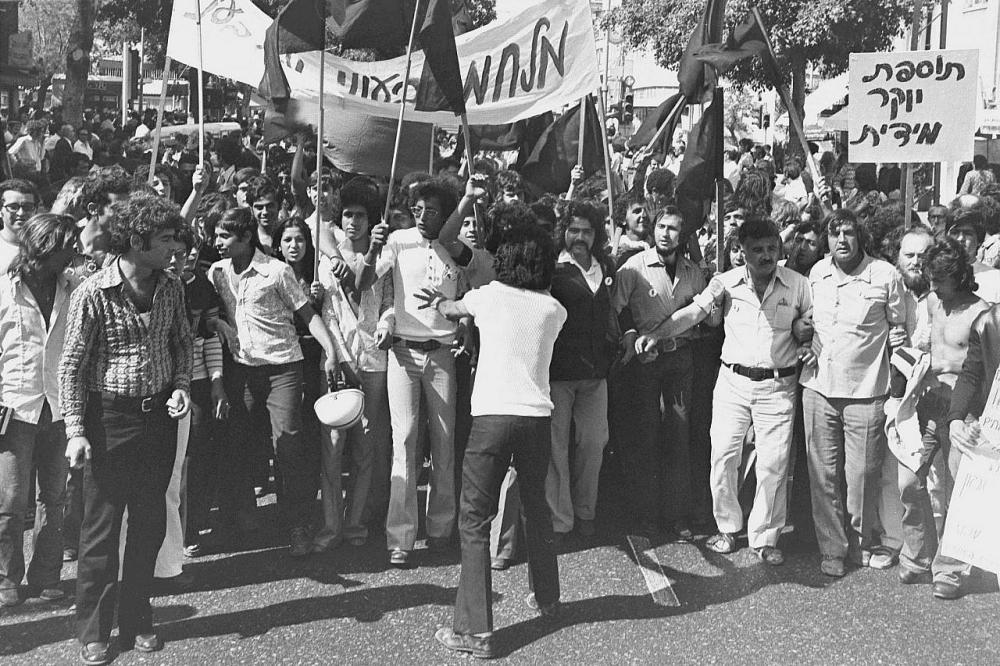
Israeli Black Panthers take part in a May Day demonstration in Tel Aviv, May 1, 1973. (Moshe Milner)
Before long, and in spite of some fairly acrimonious infighting, the Panthers sought to translate their soaring popularity into political power. A significant showing for the movement in the ballot for the Histadrut — Israel’s quasi-governmental national labor union, which was dominated by the Labor Party — in September 1973 raised hopes that they could bring about a major upheaval in the upcoming Knesset election, scheduled for late October. They campaigned on a platform that called for universal health insurance, increased welfare support, and the freeing of all prisoners.
But three weeks before the polls, on Oct. 6, Syria and Egypt launched an attack that caught Israel completely off guard, marking the start of the Yom Kippur War. The election was postponed, and by the time it eventually took place on Dec. 31 — after the nation had buried over 2,500 troops — the public’s attention was focused squarely on issues of national security. The Panthers’ momentum, built up over the span of nearly two years, had completely fizzled, and they failed to cross the minimum vote threshold required to enter the Knesset.
Over the next few years, the Panthers would try to regroup and recover from their electoral defeat. But the mood inside the country had changed dramatically, and there was little interest in “social” issues anymore. By the time the next election came around four years later, a series of splits meant that the Panthers were represented across four different lists. Two of the leadership cadre entered the Knesset — Charlie Biton, with the Arab-Jewish party Hadash, and Saadia Marciano, with the Left Camp of Israel (Sheli) — where they went on to promote the Panthers’ cause inside the corridors of power.
But most of the Panthers’ traditional base didn’t vote for either of these leftist parties. Instead, in what’s remembered as the “Ballot Rebellion” of 1977, they opted en masse for the right-wing Likud party of Menachem Begin, an Ashkenazi populist who courted Mizrahim disaffected with decades of Labor hegemony while attacking Meir’s government for its security failures. Nearly half a century later, it is Likud — and Begin’s eventual successor as party leader, Benjamin Netanyahu — that reigns supreme in Israeli politics, thanks in no small part to a loyal base of Mizrahim.
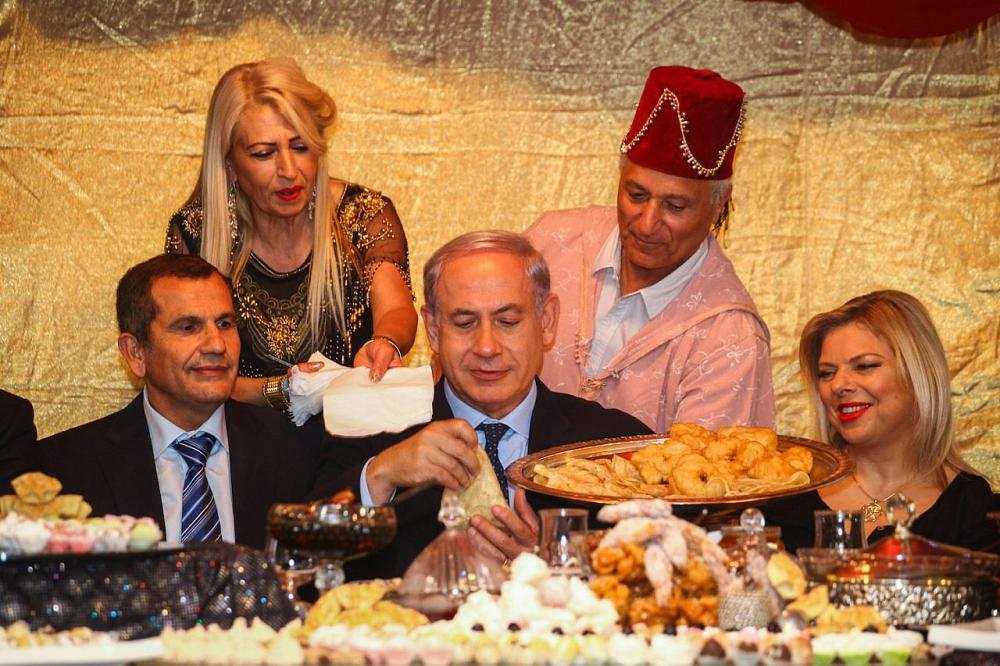
Prime Minister Benjamin Netanyahu and his wife Sara attend the Jewish Moroccan Mimouna celebrations, Or Akiva, April 21, 2014. (Avishag Shaar Yashuv/Flash90)
“If we want to understand how Netanyahu maintains power, and where the alliance comes from between a large chunk of the Mizrahi public and the Likud party, the Panthers help us understand how we got there — even if the causation is a little complicated,” Elia-Shalev explains. “The Panthers brought to the surface not just the squalid conditions that were living in, but also the injustice of it, and they told people who to blame: the Labor-dominated Israeli government.
“By attacking the old order over and over again, they freed people to rebel and to seek an avenue into power and belonging,” he continued. “The Mizrahi public by and large didn’t follow the Panthers after they unleashed this rebellion. The person who was able to capitalize on the energy was Menachem Begin, who said [to Mizrahim]: ‘I’m offering you a place on center stage. You’re the real Jews, the real warriors of this country. Come, join me.’ That was very appealing, and it worked.”
Unresolved grievances
With widespread Mizrahi assent to Likud hegemony, the socioeconomic chasm between Mizrahim and Ashkenazim that characterized the era of Labor rule has certainly narrowed over the past five decades, even if concrete data remains hard to come by. Mizrahi culture flourishes in Israel today, and the authorities have taken concrete steps toward recognizing some past injustices.
Yet vast inequalities still remain. Albeit to a far lesser extent than Palestinian citizens of Israel, Mizrahim are effectively barred from accessing or living in certain parts of the country due to racist laws and practices emanating largely from the Zionist left. They are underrepresented in fields such as media, academia, law, and politics. There has never been a Mizrahi prime minister, and only a handful of Mizrahim have been appointed to the most highly coveted government ministries.
The army, too, reflects Israel’s enduring ethnic-class divide, with Ashkenazim commonly chosen for command positions and intelligence units; Mizrahim, on the other hand, are more likely to be the cannon fodder for combat units — even as they have increasingly begun to assert their power from below. And after enduring tortuous legal struggles for housing rights, Mizrahim continue to be evicted from the very homes that the state settled them in three generations earlier. The “bastards who reaped the fruits of the struggle,” as Abergel put it, have failed to bring about the profound changes that the Panthers envisioned.
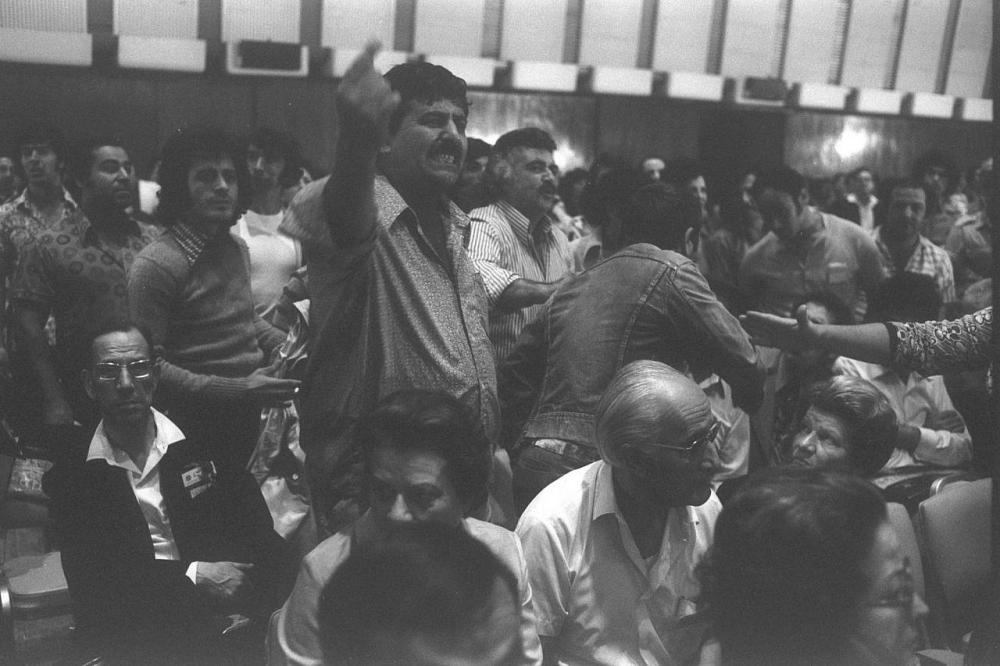
Members of the Israeli Black Panthers disrupt the opening session of the World Congress of North African Immigrants in Tel Aviv, October 25, 1975. (Ya’acov Sa’ar)
By the 1980s, many Mizrahim had already grown disillusioned by Likud’s inability to turn its rhetoric into material action, and found a home in new religious Mizrahi parties: first Tami, which gained three MKs in the 1981 election, and then Shas, which has grown since 1984 to become a major force in Israeli politics. Rather than continuing where the Panthers left off, however, critics have characterized Shas as merely “the state’s subcontractor for welfare services to the needy.” More recently, growing numbers of Mizrahim have found a home on the radical right, with Israel’s National Security Minister Itamar Ben-Gvir, who is of Mizrahi heritage himself, succeeding where his idol Meir Kahane failed.
None of this has stopped Likud and Netanyahu from continuing to present themselves as saviors of the Mizrahim and the champions of the downtrodden masses — even invoking the memory of the Panthers in doing so. “It’s interesting to see nostalgia for the Panthers on the Israeli right, Elia-Shalev remarked. “You’d never see the Republican Party being nostalgic for the Black Panther Party of Oakland. But Likud has very effectively tapped into Mizrahi grievances, and they obscure the fact that the Panthers were a distinctly left-wing group, with a very radical program that called for a socialist economy and recognition of a Palestinian state.”
Nonetheless, Elia-Shalev is not convinced that the bond between Mizrahim and the right is unbreakable, especially in the wake of October 7 and Netanyahu’s desperate attempts to cling to power as his public support wanes. “I think Israel is going through a paradigm shift right now — similar to the shift that followed the 1973 War, which ultimately led to the downfall of Labor and the rise of Likud,” he said.
“It might not happen tomorrow; it could take a few years like it did after 1973. But I think we’re going to see the downfall of Likud and the rise of something else,” Elia-Shalev continued. And the legacy of the Panthers suggests, if the Israeli political map is redrawn, that an alternative Mizrahi political vision may still be possible.
Ben Reiff is an editor at +972 Magazine and Vashti Media. Twitter: @bentreyf.
Our team at +972 Magazine has been devastated by the horrific events of this latest war. The world is reeling from Israel’s unprecedented onslaught on Gaza, inflicting mass devastation and death upon besieged Palestinians, as well as the atrocious attack and kidnappings by Hamas in Israel on October 7. Our hearts are with all the people and communities facing this violence.
We are in an extraordinarily dangerous era in Israel-Palestine. The bloodshed has reached extreme levels of brutality and threatens to engulf the entire region. Emboldened settlers in the West Bank, backed by the army, are seizing the opportunity to intensify their attacks on Palestinians. The most far-right government in Israel’s history is ramping up its policing of dissent, using the cover of war to silence Palestinian citizens and left-wing Jews who object to its policies.
This escalation has a very clear context, one that +972 has spent the past 14 years covering: Israeli society’s growing racism and militarism, entrenched occupation and apartheid, and a normalized siege on Gaza.
We are well positioned to cover this perilous moment – but we need your help to do it. This terrible period will challenge the humanity of all of those working for a better future in this land. Palestinians and Israelis are already organizing and strategizing to put up the fight of their lives.
Can we count on your support ? +972 Magazine is a leading media voice of this movement, a desperately needed platform where Palestinian and Israeli journalists, activists, and thinkers can report on and analyze what is happening, guided by humanism, equality, and justice. Join us.

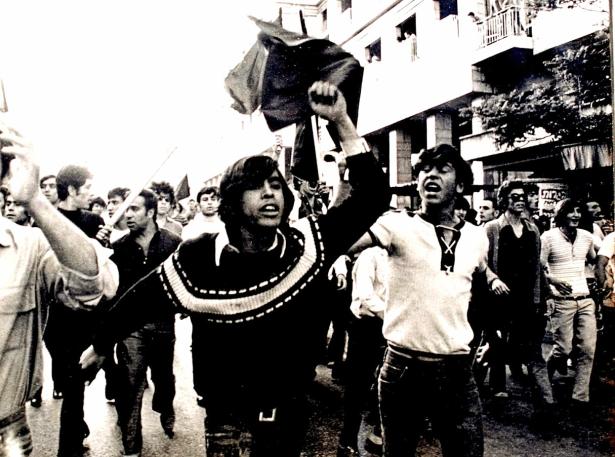
Spread the word